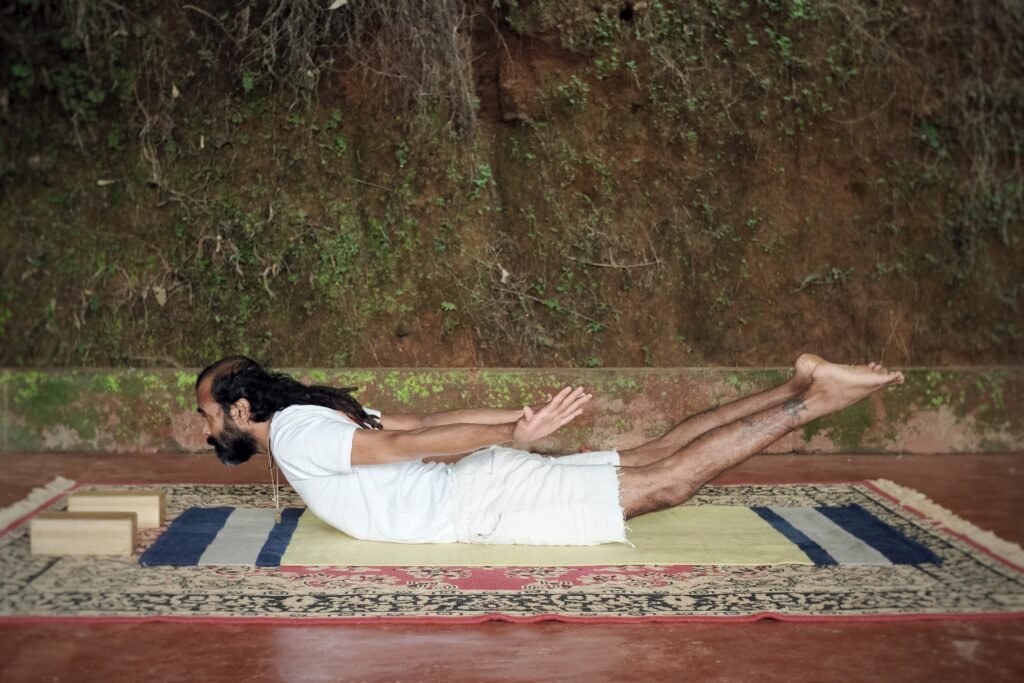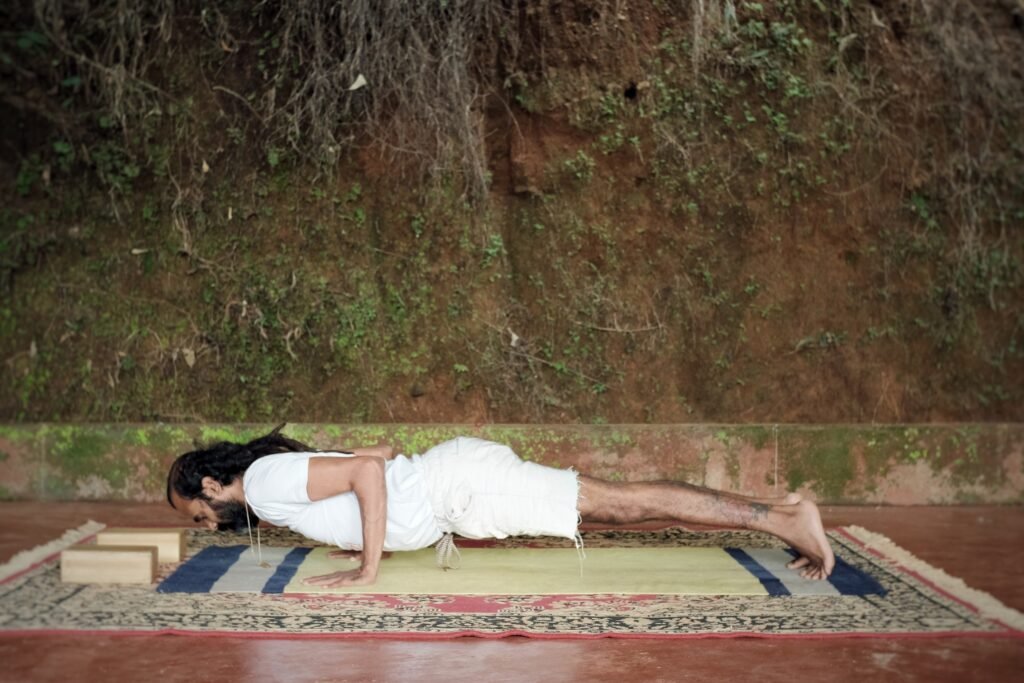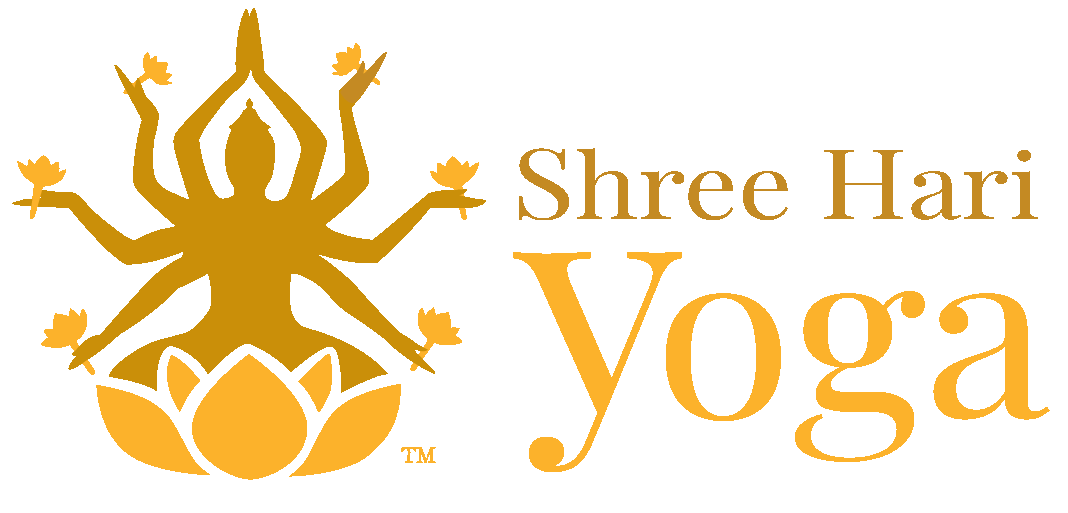
Locust Pose (Salabhasana) is a prone balancing pose. Shalabhasana, as the name suggests, is Sanskrit for “grasshopper.” Therefore, in this position, the body will resemble a grasshopper bug. This dynamic position demands energy and muscle to complete since it moves against gravity.
STEPS FOR LOCUST POSE:
- Put your chin or forehead on the mat while lying on your stomach with your arms by your side.
- As you exhale, lengthen your lower back by gently pushing your pubic bone into the floor. You should also bring your navel into your spine.
- Put your leg muscles to work.
- Lift your head, chest, arms, and legs off ground as you inhale, pressing your shoulder blades firmly against your back to enlarge your chest.
- You may see someone gently tugging you back to go higher while holding your hands.
- Although they should be hip-width apart, the feet should be pulled nearer the midline.
- Ensure your breathing is calm and steady throughout the whole five-breath period.
- Lower yourself out of the stance as you exhale, then do this two more times.
- By forming a cushion for your face with your arms and allowing your heels to drift apart, you may take a break between each posture.

(Salabhasana)Locust Pose Advantages:
-
-
Stretches, Strengthens, Lengthens:
-
When the student raises the body off the floor from Reverse Corpse Pose Head Sideways, the muscles in the spine, core, legs, hips, and upper torso are engaged. Stretching the quadriceps, hamstrings, psoas, ankles, and shin muscles are done in the locust pose (Salabhasana). It makes the knees and lower back stronger and aids in the thigh and gluteal muscle toning. The abdominal pressure tones the muscles and promotes belly fat burning.
A significant stretch of the whole back and the core will also occur, maintaining the spine’s flexibility and fortifying the back.
-
-
Flexibility and range of motion:
-
Strengthening the legs and lower and mid-back improves these muscles’ overall strength, which is good for agility. The prone posture makes it possible to do this pose, which features a mild backbend. The entire stretch improves muscle flexibility and strengthens the joints.
The learner may go from the locust pose to various poses over time, including the locust pose with bound hands and the locust pose with hands behind the head.
-
-
Chest, Diaphragm, and Breath:
-
The instructor should always instruct pupils to take a deep breath before entering the pose since breathing is one of the most crucial aspects of the locust posture.
Even though this stance opens the chest, the strain on the lower chest causes constriction.
The adduction of the shoulder blades during the backbend expands the upper and mid back.
The heart rate rises when this position is maintained for a while, maintaining breath awareness and providing a cardio exercise impact.
-
-
Awareness and Focus (Concentration):
-
In this position, the learner simultaneously elevates their upper and lower bodies as they inhale.It is simple to align to the position because of this breath awareness.
Breath awareness and core strength help to accomplish the pose’s necessary balance.
-
-
Alignment and Posture:
-
Locust Pose, a popular backbend exercise, prepares the back, core, shoulders, chest, legs, and arms for more challenging poses that call for strength throughout the body.
Regularly doing this position will teach you the proper alignment required to develop your backbends effortlessly.As you advance in your practice, stability makes it possible to maintain the position for longer while developing stronger muscles.
The elimination of extra body fat from the hips, buttocks, core, legs, and chest ultimately contributes to having a toned figure.
-
-
Energizing, relaxing, and de-stressing:
-
The lovely full-body energizer, known as locust pose, helps to relax the mind while limiting concentration for a brief period. It is an instant source of energizing positivity and leaves you feeling mentally well-balanced.It relieves stiffness in the neck, legs, and lower back.
The muscles and joints, from the tips of the fingers to the tips of the toes, are loosened due to the symmetrical body extension. In addition, it aids in energizing the autonomic nervous system, especially the parasympathetic areas in the neck and pelvis, that aid in stress reduction.After doing this stance, the pupil feels energized, at ease, and light.
-
-
Stimulation of Systems, Organs, and Circulation:
-
This position stimulates the thyroid glands and the digestive system.The core and lumbar spine are strengthened as a result of the strain on the abdomen.The whole-body stretch improves blood circulation throughout the body.
The thyroid glands are triggered as a result of the neck stretch.It maintains a healthy balance in the generation of thyroxine, which is crucial for the smooth operation of the reproductive system and preserving bone and joint health.
Stimulating the parasympathetic nerves in the lower back is the major advantage of this position.The nerve system and brain activity are both calmed by this stance.
-
-
Therapeutic, Healing and Ailments:
-
Yoga instructors employ the therapeutic Locust Pose (Salabhasana) to treat diabetes, thyroid imbalance, osteoporosis, and lower back discomfort. With this stance, you may treat conditions,including minor sciatica, constipation, and flatulence.
Women with menstruation issues may practice this asana to aid in the healthy functioning of the organs since it puts a lot of pressure on the lower abdomen.
It aids in the treatment of uncomfortable period problems and irregular period syndrome.
-
-
Balance and Emotions:
-
This position activates the root (Muladhara), solar plexus (Manipura), and sacral (Swadisthana) chakras.These three fundamental chakras produce balance, steadiness, creativity, and emotions.This promotes personality development.
When the Vishuddha and Heart (Anahata chakra) are activated, a person becomes self-assured, kind, and able to communicate clearly.
-
-
Others:
-
Adults, teenagers, ladies, athletes, and swimmers may practice this flow. It offers swimmers the power to strengthen their back and muscles, which is advantageous for swimming. This position is beneficial for deep-sea divers. This position helps the learner become used to breathing when their chest is constricted, which is necessary for swimming underwater.
-
-
Preparatory Posture:
-
Locust Pose (Salabhasana), which serves to strengthen the lower back and the core, is a preparatory pose for all back-bending asanas.
Locust Posture (Salabhasana) Contraindications:
-
-
Injury and Surgery:
-
Students with injuries to the ankles, knees, hips, pelvis, rib cage, or shoulders should be discouraged from practicing this pose.Students who have recently had surgery or who have had surgery in the past on any part of their bodies, including their ankles, knees, hips, shoulders, spine, or any abdominal organs or the heart, should take additional measures or avoid the practice, depending on the circumstances.
-
-
Lack of body-breath connections:
-
Students should be mindful of their breathing when entering and exiting the position, as well as how to coordinate their breath.
List the justifications for why something is necessary (one is to avoid injury or strain).
-
-
Physical Strength and Weak Body:
-
Since this position tightens the whole body from the hips to the feet, students who have severe sciatica may experience pain while assuming it.
This procedure should be avoided by anybody with severe menstrual issues or a prolapsed uterus since the pressure it puts on the abdomen may be hazardous.
Although the heart is open, the prone position exerts pressure on the chest and abdomen, making it unsuitable for asthma patients.
Due to the abdominal pressure, this position should be avoided for peptic ulcers students.
The major arteries close to the neck are put under strain by the modest chin pressure. Depending on their ability, they can do it for brief periods.
Patients with heart conditions shouldn’t do this pose at all.
-
-
Others:
-
This flow should not be practiced by pregnant women since it requires a prone posture, which is bad for the womb and the baby.
To prevent damage to the hips, pelvis, or rib cage, postpartum women should avoid this flow for the first four weeks after childbirth, as should elderly persons.
